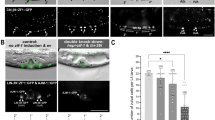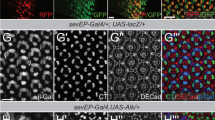Abstract
CERTAIN cell fate decisions are specified by cell–cell interactions during the development of the nematode Caenorhabditis elegans. For example, in a wild-type hermaphrodite gonad, two cells, Z1.ppp and Z4.aaa, have the potential to become the anchor cell (AC)1. Intercellular communication establishes their fates and ensures that only one cell becomes the AC, while the other becomes a ventral uterine precursor cell (VU)2,3. One component of this intercellular communication seems to be the 'AC-to-VU' signal from the presumptive AC that causes the other cell to become a VU3. Genetic and developmental studies3,4 indicate that the lin-12 gene specifies the fates of Z1.ppp and Z4.aaa. Molecular studies5,6 suggest that lin-12 directly participates in their communications, perhaps acting as the receptor for the 'AC-to-VU' signal3. Here, we report the molecular lesions associated with lin-12 gain-of-function mutations, cell isolation experiments, and genetic studies of an unusual lin-12 allele. These data suggest that self-association of the putative lin-12-encoded receptor leads to its activation, and that certain gain-of-function mutations result in ligand-independent activation.
This is a preview of subscription content, access via your institution
Access options
Subscribe to this journal
Receive 51 print issues and online access
$199.00 per year
only $3.90 per issue
Buy this article
- Purchase on Springer Link
- Instant access to full article PDF
Prices may be subject to local taxes which are calculated during checkout
Similar content being viewed by others
References
Kimble, J. & Hirsh, D. Devl Biol. 70, 396–417 (1979).
Kimble, J. Devl Biol. 87, 286–300 (1981).
Seydoux, G. & Greenwald, I. Cell 57, 1237–1245.
Greenwald, I. S., Sternberg, P. W. & Horvitz, H. R. Cell 34, 435–444 (1983).
Greenwald, I. Cell 43, 583–590 (1985).
Yochem, J., Weston, K. & Greenwald, I. Nature 335, 547–550 (1988).
Muller, H. J. Proc. int. Congr. Genet. 6, 213–255 (1932).
Fischer, S. G. & Lerman, L. S. Proc. natn. Acad. Sci. U.S.A. 77, 4420–4424 (1980).
Myers, R. M., Sheffield, V. C. & Cox, D. R. in Genomic Analysis: A Practical Approach (ed. Davies, K.) 95–139 (1989).
Higuchi, R. G. & Ochman, J. Nucleic Acids Res. 17, 5865 (1989).
Hartley, D. A., Xu, T. & Artavanis-Tsakonas, S. EMBO J. 6, 3407–3417 (1987).
Kelley, M. R., Kidd, S., Deutsch, W. A. & Young, M. W. Cell 51, 539–548 (1987).
Wharton, K. A., Johansen, K. M., Xu, T. & Artavanis-Tsakonas, S. Cell 43, 567–581 (1985).
Kidd, S., Kelley, M. R. & Young, M. W. Molec. cell. Biol. 6, 3094–3108 (1986).
Kidd, S., Baylies, M. K., Gasic, G. P. & Young, M. W. Genes Dev. 3, 1113–1129 (1989).
Yochem, J. & Greenwald, I. Cell 58, 553–563 (1989).
Heffetz, D. & Zick, Y. J. biol. Chem. 259, 889–894 (1986).
Boni-Schnetzler, M., Rubin, J. & Pilch, P. F. J. biol. Chem. 259, 11543–11549 (1986).
Yarden, Y. & Schlessinger, J. Biochemistry 26, 1434–1442 (1987).
Yarden, Y. & Schlessinger, J. Biochemistry 26, 1443–1451 (1987).
Weston, K., Yochem, J. & Greenwald, I. Nucleic Acids Res. 17, 2138 (1989).
Brenner, S. Genetics 77, 71–94 (1974).
Ferguson, E. L. & Horvitz, H. R. Genetics 110, 17–72 (1985).
Author information
Authors and Affiliations
Rights and permissions
About this article
Cite this article
Greenwald, I., Seydoux, G. Analysis of gain-of-function mutations of the lin-12 gene of Caenorhabditis elegans. Nature 346, 197–199 (1990). https://doi.org/10.1038/346197a0
Received:
Accepted:
Issue Date:
DOI: https://doi.org/10.1038/346197a0
This article is cited by
-
Normal sleep bouts are not essential for C. elegans survival and FoxO is important for compensatory changes in sleep
BMC Neuroscience (2018)
-
Structural basis for autoinhibition of Notch
Nature Structural & Molecular Biology (2007)
-
Cell fate-specific regulation of EGF receptor trafficking during Caenorhabditis elegans vulval development
The EMBO Journal (2006)
-
Cancer Genetics: Activated Notch takes center stage in T-cell leukemogenesis
European Journal of Human Genetics (2005)
-
The Notch Pathway: Modulation of Cell Fate Decisions in Hematopoiesis
International Journal of Hematology (2002)
Comments
By submitting a comment you agree to abide by our Terms and Community Guidelines. If you find something abusive or that does not comply with our terms or guidelines please flag it as inappropriate.



